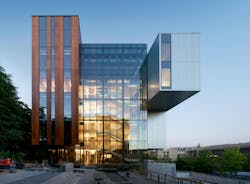Enhancing Comfort and Efficiency with Radiant Cooling Systems
Radiant cooling systems are gaining popularity in modern buildings due to their numerous benefits, including enhanced comfort, low maintenance, improved indoor air quality, greater energy efficiency, reduced operating costs, and architectural versatility.
By using radiation to maintain indoor thermal comfort with lower energy consumption, these systems provide stable temperature control and reduce reliance on forced air, contributing to a quieter, healthier indoor environment while working in tandem with ventilation for optimal air quality.
The article below will delve into high-performance trends and the latest research on radiant cooling systems, exemplifying how they can enhance the well-being and comfort of those who spend time in these buildings.
Principles of Radiant Cooling Systems
HVAC systems that transfer more than 50 percent of heat through radiation can be classified as radiant systems. The most common types include ESS (Embedded Surface Systems), where PEX piping is embedded in concrete thermal mass or surfaces like floors, walls, or ceilings, and radiant ceiling panels, where pipes are attached to the back of the ceiling panels.
Heating mode raises the surface temperature until it begins to radiate heat toward the occupied space, increasing the mean radiant temperature. In cooling mode, the system absorbs heat from the space by lowering the average surface temperature of the room, as warm surfaces always radiate heat to cooler ones.
A hybrid system is needed because radiant systems handle sensible loads but cannot control humidity or manage latent cooling load. A Dedicated Outdoor Air System (DOAS) addresses these needs by providing fresh air and controlling humidity to meet ASHRAE 62.1 standards. Hybrid systems also offer flexibility during heating-to-cooling changeovers or shifts in occupancy, ensuring optimal comfort and ventilation.
Thermal Comfort
Comfort is more than just a thermostat setting; it’s influenced by a combination of internal and external factors from ASHRAE 55: air temperature, air speed, humidity, metabolic rate, clothing insulation and mean radiant temperature.
Hybrid radiant systems enhance comfort by actively regulating mean radiant temperature and operative temperature, key metrics used in thermal comfort standards, including those referenced in LEED. By absorbing heat through radiation, these systems reduce reliance on excessively cold air for cooling. Unlike forced-air systems, radiant cooling delivers uniform temperatures without drafts or uneven airflow, a common issue in office buildings, so you’re less likely to need a sweater in the middle of summer!
System Efficiency
Radiant cooling systems are highly efficient, reducing a building’s total energy use by operating at higher cooling setpoints. They also use warmer chilled water temperatures, improving chiller efficiency, making them ideal for heat pumps or renewable sources. Water stores 3,400 times more thermal energy per unit volume than air, and circulating it uses 75–90 percent less energy than moving air with a blower fan while reducing transmission losses. Additionally, these systems offer thermal storage potential to reduce peak loads and shift operation to off-peak hours, further enhancing efficiency.
A research study by the New Buildings Institute on site energy use found that radiant buildings are more energy-efficient than 90 percent of comparable buildings, with two-thirds achieving an EnergyStar score of 90 or higher. The study also highlighted that data from two independent studies revealed that most net-zero energy buildings incorporate radiant systems. This suggests that top designers recognize radiant systems as a key strategy for achieving low-energy performance.
Impact of Solar Gain and Ceiling Fans
Maximum radiant cooling capacity under standard conditions is about 40-50 W/m2 [13-16 Btu/h.ft2], which is limited by relatively small heat transfer coefficient between active surfaces and air. Also, low floor temperatures increase risks of condensation and occupant discomfort. Studies have shown that radiant cooling capacity significantly increases under direct sunlight, reaching >100 W/m2 [>31 Btu/h.ft2].
When paired with radiant cooling systems, ceiling fans promote more building efficiency, improved air quality and cooling properties. A Computational Fluid Dynamics (CFD) simulation was conducted by CBE (Center for Built Environment) to examine how heat transfers between a cooled floor or ceiling and the surrounding air. The results in the study showed that using a ceiling fan to enhance air movement improved airflow within the room, boosting natural convection and increasing the efficiency of the radiant cooling system. In fact, the study found that greater air movement could enhance radiant cooling capacity by up to 30 percent.
Design Opportunities
Radiant cooling systems offer a versatile and energy-efficient solution for various applications, including schools, offices, hospitals, and spaces with large glazed surfaces such as atriums, airports and transit hubs. With proper design and controls, condensation risks can be effectively managed in most climates.
Strategic load shifting enhances efficiency by allowing DOAS and radiant cooling to operate at different times and temperatures using the same heat pump. Additionally, the ability to run at warmer supply temperatures enables cooling tower economizer operation, further reducing energy consumption.
Conclusion
With increasing electrification and decarbonization efforts, radiant cooling’s ability to integrate with heat pumps and renewable energy sources positions it as a key technology for high-performance buildings. Research shows that radiant-cooled buildings consistently achieve top-tier energy performance, making them a proven solution for the future of sustainable design. By reducing peak loads, minimizing energy consumption and enhancing occupant comfort, radiant cooling continues to gain traction as a reliable and forward-thinking approach to modern building systems.
About the Author

Saeed Danesh
Saeed Danesh is a technical project specialist with the building solutions division of REHAU in Western Canada. He holds a master of science in mechanical engineering with a focus on energy efficiency and comfort in high-performance buildings. While tending to business development with mechanical engineers and commercial contractors, he also manages the region’s design services for radiant heating/cooling, snow- and ice-melting, geothermal and plumbing projects. In his free time, he enjoys hiking and playing soccer; camping and playing the piano. He can be reached at [email protected].

